By Dave Pluth
For several years I’ve collected photo after photo of aircraft that were captured and rebuilt at Hollandia. There never seemed to be any substantial mystery about aircraft that were in the photos beyond what groups may have rebuilt them.
The aircraft looked very similar in most respects, they were basically the same model of the Ki-43-II Oscar so the assumption that I made was that there were a couple of distinct aircraft that had just been repainted in different fashions and claimed by different units as they passed through the area and took charge of the project. That assumption couldn’t have been more incorrect.
Another remaining mystery was that of the origin of the NASM/EAA/Seattle Museum of Flight Ki-43 Oscar (this aircraft was property of the NASM, restored by the EAA museum in Oshkosh and has now landed in Seattle). No meaningful serial numbers appear on this aircraft and little is known about it origins even by the NASM. These seem like a couple of mysteries worth solving once and for all if that was possible!
The Hollandia Area

Hollandia Area Layout. Hollandia Airfield can be seen in the distance
with Sentani and Cyclops Airfields in the foreground. (Photo Credit:
Engineers of the Southwest Pacific)
The Hollandia area was home to two large airfields and two smaller poorly constructed fields. The four airfields Hollandia, Sentani, Cyclops and Tami were built by the Japanese from April 1943 to November 1943. 1 Allied forces landed April 22nd and captured these airfields on April 26, 1944. After the capture engineers used captured Japanese construction equipment to prepare the field for the first C-47 transport which landed at Cyclops Drome on April 27th.
After the invasion Tami Drome was used as a jumping off point to transport items vial C-47 to Cyclops. Cyclops became the hub of the area as transports, equipment, personnel and supplies were all routed into the area through the Cyclops Drome. The use of Tami Drome lasted only a short time as it lacked proper drainage to keep the field operational.
During the month of May Cyclops was converted from a simple dirt dry-weather strip (unusable with any type of heavy rain) to an all-weather 4000 foot by 100 foot runway. The construction of hardstands and other operations and repair buildings continued until August 1944 at which time work was suspended to move resources to the construction of Sentani and Hollandia Dromes.
Hollandia Drome had a 5,000 foot section of useable runway on which fighters were stationed on in early May 1944. A second airstrip parallel to the first at Hollandia Drome was under construction when unseasonably wet weather delayed the opening of the strip by one month. Even with the improvements made during initial construction additional work had to be done and the completion of the strip wasn’t finished until October 1944.
Sentani Drome was a 5,000 foot by 100 foot runway constructed of limestone schist with a crushed rock surface near Cyclops. Sentani had 125 all weather hardstandings and a large transport unloading area when construction was complete.
The Japanese had left much behind in their haste when they abandoned the Hollandia area in May 1944. Crude construction equipment was found in the town of Pim and derelict aircraft was left to rot in the jungle.
The wrecks ranged from unidentifiable shot up chunks of metal to relatively complete airframes that while needing work could be put back into flyable condition by a lot of hard work and some skilled and creative mechanical work.
84th Airdrome Squadron
The 84th Airdrome Squadron landed at Hollandia, New Guinea on May 13th 1944. They took over operations of the Cyclops Drome on May 21st and maintained sole operations of that field until June 20th 1944 when they were also given responsibility for Sentani Drome as well. The group remained in charge of day to day and maintenance operations at these fields until November 1st 19442.
In May of 1944 the 84th “began the painstaking task of rebuilding a Japanese ‘Oscar’ which has been turned over to it by the Air Corps Technical Intelligence Unit” according to the unit history. The rebuild of this aircraft would take the unit better than two months to complete.
According to the Unit history the unit worked simultaneously on two different Oscars and a single Ki-61 “Tony” during their time in Hollandia. To this point no documentation on the Tony has been unearthed but the Oscars have been well photographed and documented.
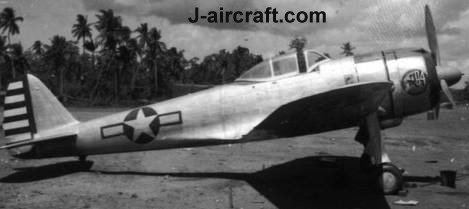
84th Airdrome Squadron Oscar #1 (photo credit Ashley Messinger)
The first Oscar (Oscar #1 in the photos) was test flown in August 1944 and suffered landing gear problems upon landing after its maiden test flight. The damage was “not too great” according to the unit history and the Engineering Section immediately began repairs of the aircraft.
The second Oscar was completed and test flown in September 1944. The test flight went very well with no major incidents.
According to S/Sgt William Garza, who was the line chief for the Oscar rebuild projects, at least one of the aircraft was put on a ship and sent back to the United States before they left the Hollandia area. 3 It was accompanied by a S/Sgt Hall who helped in the rebuild efforts and is mentioned by name in the unit history as doing so.
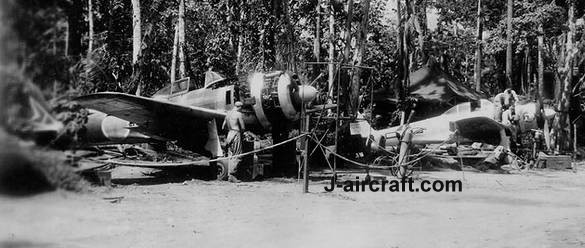
Oscar #1 in the distance highlighted by the dark colored (probably
red) cowl ring. Oscar #2 is in the foreground and can be identified
by the non-standard canopy. (Photo Credit: LRA)

The reverse side of Oscar #1. In this photo you can see the
rounded shape of the canopy and the positioning of the stars and bars. (Photo
Credit: Robert Levy)

84th Airdrome Squadron Oscar #2. You can see the different
position of the stars and bars as well as the design on the side of
the aircraft. This photo also shows a good view of the one-off canopy
that was built for this aircraft. (Photo credit: Robert Levy)

84th Airdrome Squadron Oscar #2. Another side view of this
aircraft. You can see the smaller stars and bars as well as the
flat canopy quite well from this view. You can also see the rather
distinct wheel hubs. (Photo Credit: Authors Collection)

84th Airdrome Squadron Oscar #2. An interesting item in this
photo is what looks to be a TA located above the wing, straight above
the landing gear. This photo was probably taken just before or
after the test flight of Oscar #2. Also in the foreground is
S/Sgt Garza. (Photo Credit: LRA)
Canopy Study
Sgt Garza’s story as well as the shape of the canopy would give strong evidence to the 84th Airdrome Squadron’s Oscar #2 as being the aircraft that is the one that belonged to the NASM.
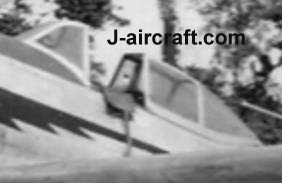
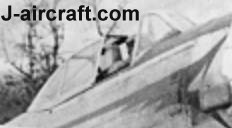
84th Airdrome Oscar #2 Canopy. (Photo Credit: Authors Collection)

Photos of the EAA Museum/Seattle Museum of Flight Oscar’s Canopy. (Photo
credit: James Jones via J-aircraft.com)
8th Fighter Squadron, 49th Fighter Group

XJ004 AKA Racoon Special in it’s original form. This
photo has been credit to various locations in New Guinea but
is at Hollandia just after all the paint was stripped from the aircraft. Note
the mountains that surround the Hollandia area in the background as
well as the C-47 on the left side of the photo. Other items
of note is the faired over light on the tail and the markings on the
landing gear.
The 8th Fighter Squadron was stationed in Hollandia from May 3rd 1944 to June 22, 1944 as part of the 49th Fighter Group.
The aircraft that the 8th FS selected to rebuild was a former 59th Sentai Oscar Model 2 that was left in the trees near the Cyclops runway.4 Fortunately for the group there was a veritable Japanese spare parts store in the form of other wrecks that were strewn throughout the field and jungle.
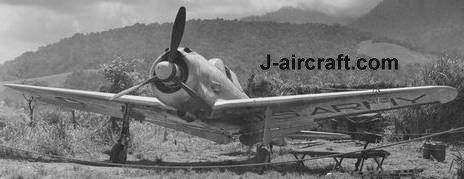
Racoon Special. Note the US ARMY on
the underside of the wing. The aircraft was moved and kept in
a roped off area under armed guard to prevent souvenier hunters from
stripping it.
During the rebuilding of Racoon Special the aircraft would get new control surfaces, a rebuilt engine and have it’s landing gear completely reconstructed. Even a set of 12.7mm guns were rebuilt and put into the Oscar before its reconstruction was complete.
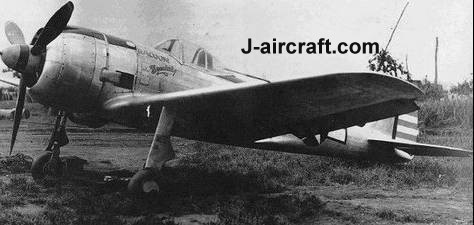
Racoon Special in it’s final 8 Fighter Squadron Form. Note
the unit markings on the wheel hubs as well as the Racoon Special!
On the fuselage.
After reconstruction was complete the aircraft was stripped to bare metal and given pre-war red, white and blue markings on the tail with oversized stars and bars on the fuselage and wings. The finishing touch was put on when the name Racoon Special! (which was actually misspelled) was added to the fuselage. Racoon Special was the call sign of the 8th FS (Blacksheep).5
The 8th FS has help from Air Technical Intelligence on their build when on June 10th a group from the Air Technical Intelligence center in Brisbane arrived to complete the aircraft. The 8th FS had received orders to move forward to the Philippines and leave their Oscar behind. The group was disheartened by this development and appealed to Brigadier General Donald Hutchinson who was so moved by the group’s presentation that he ordered that 8th FS would finish the build.
On June 21st, after successful preflight tests, and following a 24-hour notice to all anti-aircraft and air corps units, the Oscar once again took flight with Major Bob McHale at the controls. The flight was joined by a silver P-40 piloted by Group Operations Officer Major Robert McDaris.
McHale and McDaris put on a mock combat to put the Oscar through it’s paces. The unit found “that the Oscar rolled, turned sharply, and split esses to get on the P-40’s tail repeatedly, even though Major McDaris is as a pilot of no mean ability, with a great number of P-40 combat hours and two enemy planes to his credit.”6
The aircraft was flown on at least one more occasion by Major Arland Stanton of the 7th Squadron and also flew a second mock combat against a group P-40 with the same result.

Racoon Special at Eagle Farm in Brisbane. Note
XJ002 a capture Ki-61 in the background.
When the unit left Hollandia the aircraft was left behind with T/Sgt
Bruno Topik (who was in charge of the rebuild of the aircraft) as it’s
crew chief. The aircraft was transferred to Brisbane and transferred
to the ATIU for further testing.7
41st Troop Carrier Squadron.
The 41st Troop Carrier Squadron arrived in the Hollandia area on May 25th 1944 and remained there until November 16th, 1944. Little is know about the 41st at this writing except that a Ki-43 Oscar was rebuilt by the unit. This was most likely done during off-hours while in the Hollandia area.

The 41st Troop Carrier Squadron Oscar. Note the unit insignia on
the side of the aircraft. The banner says “Rebuilt By the
41st Troop Carrier Sq.” (Photo Credit: Justin Taylan – PacificWrecks.com)

This is a second view that is believed to be a later view of the aircraft. Note
the red/white/blue striped tail with XJ005 a TAIC identifier number. Also
note the wheel hubs with the 5th AF insignia on it. (Photo Credit: Jim
Kaltenhauser)

This photo is reported to be taken before the first
flight test. The
event is actually unknown at this time. The photo however clearly
shows “US Army” under the wing, the wheel hubs with the 5th
AF insignia with a red/white/blue tail and the XJ005 numbering on it. (Photo
Credit: Ken Blackman)

This photo is taken from the same position with
the aircraft remarked for identification photos. (Photo credit:
Famous Aircraft of the World)
So which Oscar is the real NASM/EAA/Seattle Museum of Flight aircraft?
Some theories present that an Oscar was captured in China an moved through India to the United States and that this aircraft is “most likely” the NASM Oscar. There is a chance that this is indeed true as records indicate an Oscar in the TAIC inventory and being rebuilt at Anacostia or Wright Field (the documentation is unclear as to location).
A more likely scenario that fits both the aircraft and the story as told by Crew Chief Garza is that the second 84th Airdrome Squadron aircraft is that Oscar. Garza’s story about the aircraft being put aboard a ship and sent back to the US, along with the very unique canopy setup that the 84th aircraft had, it seems likely that this is indeed the NASM aircraft.
Is it also a definite possibility that the NASM aircraft is a set of mismatched parts from various aircraft and that the canopy is one of the surviving pieces from the 84th aircraft.
This aircraft may always remain a mystery as no real records exist for it. For now we do know that at least four aircraft were rebuilt at the various strips at Hollandia and that each had it’s own unique identifying characteristics.